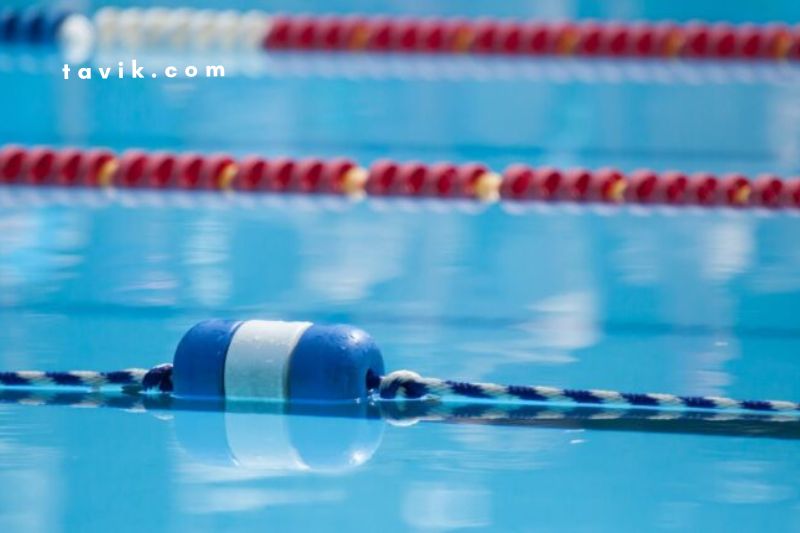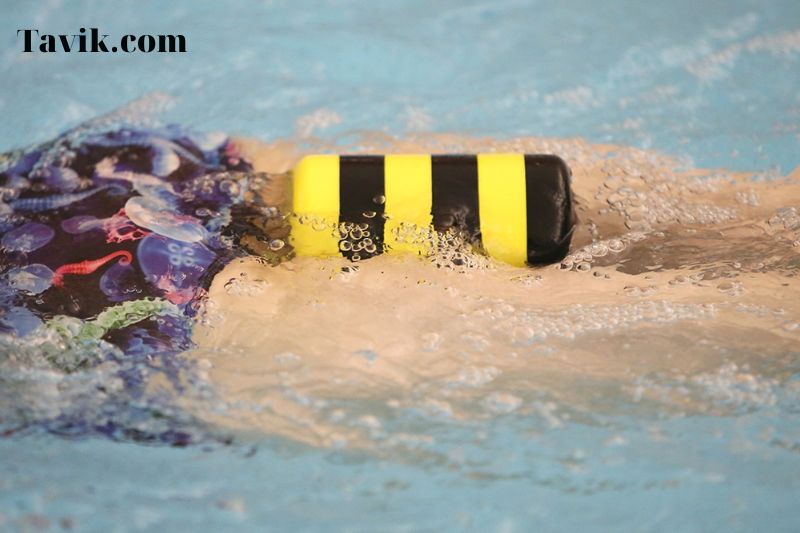Have you ever seen someone effortlessly glide across the water on a surfboard, with no waves in sight? If so, you were probably witnessing the magic of wake surfing. Wake surfing is a relatively new watersport that is quickly gaining popularity. It's a great way to enjoy the water and get a workout at the same time. If you're interested in trying wake surfing, in this article, Tavik will provide a simple guide on How to Wakesurf.
What You'll Need to Wakesurf?
 Of course, you'll need a boat to go wake surfing, but what else do you need? You'll need your boardshorts or swimsuit, a wake surf board, a wake surf rope, and, maybe most importantly, a life jacket that fits properly. It's essential to be prepared before getting out on the lake. The first step is deciding what to wear. A swimsuit is self-evident, but there are a few things to remember. While you may want to flaunt your summer physique, going for a swimsuit with more excellent coverage will assist in keeping you safe. Keep in mind that you'll be wearing a life jacket, so pick a swimsuit that is supportive and comfortable beneath it. Wakesurfers who are new to the sport may consider donning a wetsuit or rashguard. You'll probably spend more time in the water as a novice, which might be cold depending on where you are. More covering also ensures you are more protected in the event of a fall. A life jacket is likely the most crucial gear you'll wear when wake surfing. Life jackets will not only keep you afloat, but they will also protect you if you fall. Make sure you have a life jacket rated for size and weight and approved by the Coast Guard.
Of course, you'll need a boat to go wake surfing, but what else do you need? You'll need your boardshorts or swimsuit, a wake surf board, a wake surf rope, and, maybe most importantly, a life jacket that fits properly. It's essential to be prepared before getting out on the lake. The first step is deciding what to wear. A swimsuit is self-evident, but there are a few things to remember. While you may want to flaunt your summer physique, going for a swimsuit with more excellent coverage will assist in keeping you safe. Keep in mind that you'll be wearing a life jacket, so pick a swimsuit that is supportive and comfortable beneath it. Wakesurfers who are new to the sport may consider donning a wetsuit or rashguard. You'll probably spend more time in the water as a novice, which might be cold depending on where you are. More covering also ensures you are more protected in the event of a fall. A life jacket is likely the most crucial gear you'll wear when wake surfing. Life jackets will not only keep you afloat, but they will also protect you if you fall. Make sure you have a life jacket rated for size and weight and approved by the Coast Guard.
How to Choose a Beginner Wakesurf Board?
Choosing the correct beginning wake surfboard can help you learn faster while also allowing you to have more fun. Beginner wake surfers place a greater emphasis on stability and predictability than on speed and pop. Wakesurf boards in the form of a surfboard with a greater surface area and a reliable three-fin layout are recommended. This will give you the most solid and forgiving base from which to learn the fundamentals. Construction and buoyancy are two additional characteristics of novice wake surfers. Beginner boards are often composed of less buoyant materials, allowing them to sit lower in the water for slower speeds and better stability. You may get to super poppy and simply agile boards from there. Check out our wake surf board buying guide for more information.
Get the Right Equipment
 If you're just getting started in wake surfing, look for "beginning boards." Wakesurfing boards come in various shapes and sizes, and versions designed for more experienced riders might be challenging to learn to ride. Physically, the variations are minor but noticeable in how they interact with riders. The Tie: Believe it or not, rope selection is vital, and a wake surfing rope differs from a wakeboarding rope, which differs from a ski rope. Wakesurfing ropes are thicker, shorter, and have a well-padded grip. Some even feature knots to assist beginner riders in getting into the "sweet spot" of the wave, which we'll describe later. You'll also require a personal flotation device, such as a life jacket or a PFD. Modern PFDs resemble down vests rather than the blocky foam pieces you may recall.
If you're just getting started in wake surfing, look for "beginning boards." Wakesurfing boards come in various shapes and sizes, and versions designed for more experienced riders might be challenging to learn to ride. Physically, the variations are minor but noticeable in how they interact with riders. The Tie: Believe it or not, rope selection is vital, and a wake surfing rope differs from a wakeboarding rope, which differs from a ski rope. Wakesurfing ropes are thicker, shorter, and have a well-padded grip. Some even feature knots to assist beginner riders in getting into the "sweet spot" of the wave, which we'll describe later. You'll also require a personal flotation device, such as a life jacket or a PFD. Modern PFDs resemble down vests rather than the blocky foam pieces you may recall.
How to Wakesurf?
- Sit in the water with your toes and heels on the board's edge.
- Allow your knees to come into your chest as the board moves, and dig your heels down.
- Maintain a bend in your knees until the board flips up to your feet and your weight is supported by the board.
- Gently stand up and place your heels on the board.
Relax and let the boat do the job is the most popular advice offered to beginner wake surfers. If you're having trouble getting up on a wakesurf board, this may be annoying advice, but it's real! It's all about your setup and patience to get started. Sitting in the water with your feet propped up on the board, push your heels into the board until it flips up to your feet and the boat starts pulling you up. Stay patient after your feet are securely planted on the board, and bend your knees as you crouch down, leaning into the rope as your weight shifts over the board. You may slowly stand up after you're totally over the board. Beginner wake surfers often push too hard to force their feet into the board rather than allowing the boat's pull to flip it up. Another typical blunder is attempting to pull yourself up. This may work in some instances, but as you gain strength, losing your equilibrium and falling is simple. While patience is essential, you don't want to be too comfortable, laying back and staring at the sky; instead, you want to bend your knees and maintain an athletic posture while allowing the boat to draw you up.
How to Drop the Rope Wakesurfing?
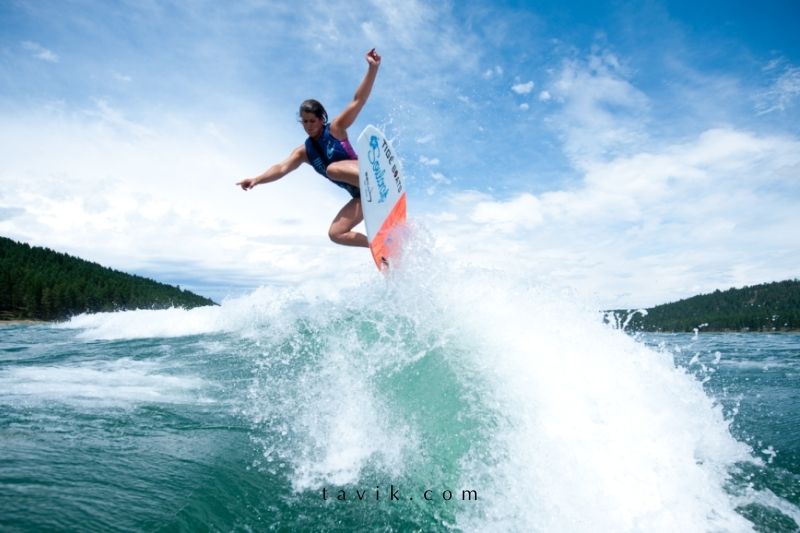 It's time to climb into that wave and drop the rope after you've gotten up! Once you've moved into the wave's pocket, the wave's push is enough to keep you riding, and you won't need the handle to keep you moving. When attempting to catch that wave and drop the rope, there are a few things to keep in mind. The first and most critical stage is to maintain proper posture; if you're all squished up, you won't be able to move about quickly and place yourself in the wave. Check whether you're standing up straight and not bending down at the waist. Place your backhand (not the one holding the handle) on your lower back, push forward, and straighten your posture to do a "posture check." As you gain a feel for moving about on the wave, having someone on the boat manage the slack in your rope is beneficial. They'll assist in smoothing any motions, so you won't be dragged off your board if your slack runs out soon. It's time to chuck the rope after you are comfortable surfing with a consistently slack line. To avoid being entangled in the rope, toss it back into the boat or over to the opposite side of the wave.
It's time to climb into that wave and drop the rope after you've gotten up! Once you've moved into the wave's pocket, the wave's push is enough to keep you riding, and you won't need the handle to keep you moving. When attempting to catch that wave and drop the rope, there are a few things to keep in mind. The first and most critical stage is to maintain proper posture; if you're all squished up, you won't be able to move about quickly and place yourself in the wave. Check whether you're standing up straight and not bending down at the waist. Place your backhand (not the one holding the handle) on your lower back, push forward, and straighten your posture to do a "posture check." As you gain a feel for moving about on the wave, having someone on the boat manage the slack in your rope is beneficial. They'll assist in smoothing any motions, so you won't be dragged off your board if your slack runs out soon. It's time to chuck the rope after you are comfortable surfing with a consistently slack line. To avoid being entangled in the rope, toss it back into the boat or over to the opposite side of the wave.
How to Control Your Speed Wakesurfing & Stay in the Wave?
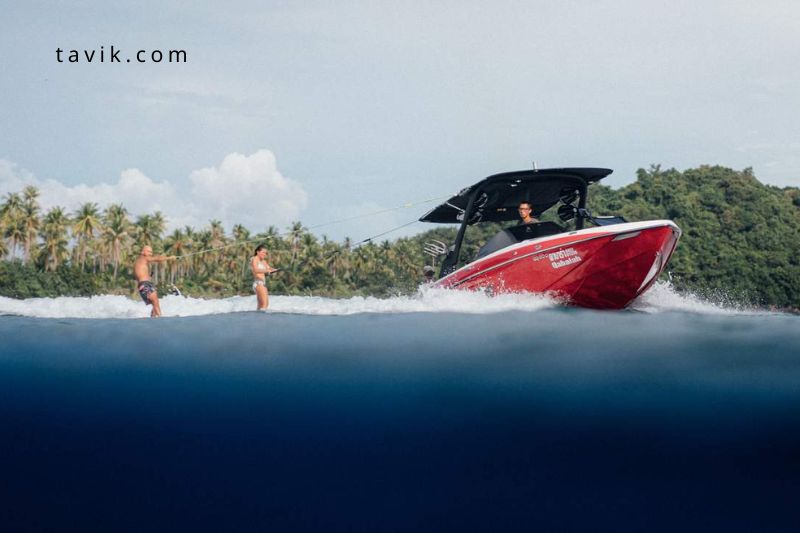 When wake surfing, changing how you weigh your feet might assist you in regulating your speed. In other words, your front foot acts as a gas pedal. To accelerate, put more weight on your front foot; to slow down, put more weight on your rear foot. Weighting your toes can also help you speed faster by forcing you into the wave while pressing your heels would do the reverse. Turn up into the wave to keep your speed and remain in the wave, then drop back down to gain up speed. If you're having trouble remaining in the wave and being dumped out the back, consider jumping back into it after you've dropped down. Similarly, if you feel like you're losing the wave, you should crank it up rather than down so you can drop back down and gain up speed. You'll be surfing like a pro after you've mastered these motions.
When wake surfing, changing how you weigh your feet might assist you in regulating your speed. In other words, your front foot acts as a gas pedal. To accelerate, put more weight on your front foot; to slow down, put more weight on your rear foot. Weighting your toes can also help you speed faster by forcing you into the wave while pressing your heels would do the reverse. Turn up into the wave to keep your speed and remain in the wave, then drop back down to gain up speed. If you're having trouble remaining in the wave and being dumped out the back, consider jumping back into it after you've dropped down. Similarly, if you feel like you're losing the wave, you should crank it up rather than down so you can drop back down and gain up speed. You'll be surfing like a pro after you've mastered these motions.
How to do a Pump Trick?
This is an intermediate technique that will assist you in generating speed and bouncing. You'll be able to perform 180s, 360s, and other stunts after mastering this skill. If you don't have the rope, you'll have to rely on your rear foot to get to the top of the wake. Then you step down the wake by putting your weight on your front foot. To produce speed, try doing this method.
5 Wakesurf Tricks You Can Try Today To Up Your Game
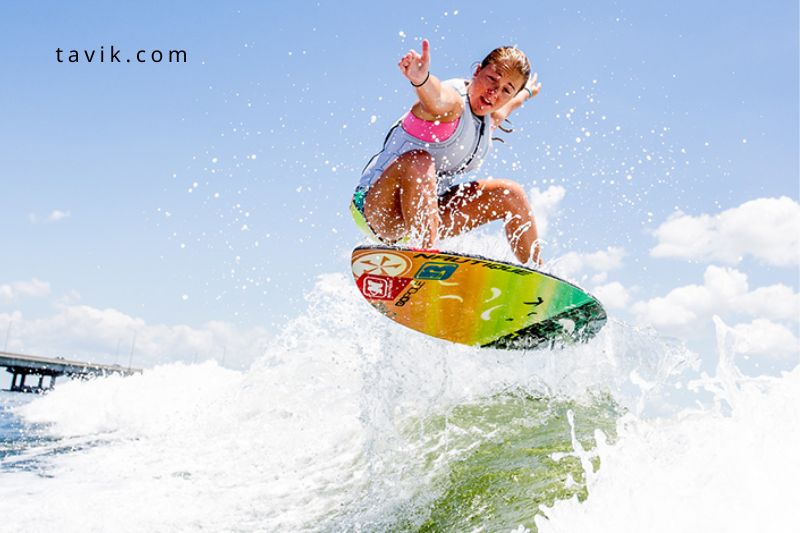
Carving
The carving technique is one of the finest "tricks" a wakesurfer can master. It's not only a fun method to surf the wake, but it also serves as a solid basis for many more complex tricks down the road, so it's definitely one worth mastering. Carving is about a smooth, back-and-forth action that allows you to rock along with the wake at your own speed. Place yourself in the middle of the board to begin. Drop back and ride the wave up by turning your board's nose up toward the crest of the wave (slightly pushing your front foot forward)—then swing back down by pushing your back foot toward the boat. This will result in a light back-and-forth motion that will allow you to easily ride the wave. The last push with your back will result in a little spray explosion... a pleasant visual flourish, particularly on a hot day.
Floating
The wake surfer's equivalent of walking on water is floatation or rising to "stand" at the wave's crest. It involves many of the same fundamental motions as carving. In fact, the arrangement is almost identical! The only difference between the two maneuvers is the follow-through. Rather than instantly moving your rear foot toward the bottom of the wave, attempt to keep your foot position as you reach the top of the wake. If you can hold it for a few seconds while applying minimal pressure to your front foot, you'll seem to be floating effortlessly at the wave's crest!
Grab the rail
Another essential tactic is the rail grab, which may be used for various things (including the fire hydrant, which we'll look at after today's list). You want to feel comfortable gripping the edge of your board with your hand as a wake surfer, and that's all the rail grab includes. Grab the front of your board while crouching low and keeping your legs close to your torso. Take a leaf from the surfer's book and grasp with your right hand if your left foot is in front (or vice versa), but that's just the beginning. Once you've mastered this maneuver, you'll understand when and where to hold your board for the most traction and control. Many people are surprised to learn that wake surfing is not a no-hands sport! Because you're not clutching a rope as you would during wakeboarding or waterskiing, you're free and encouraged to use your hands as guides when surfing. You may even put your palm in the water to slow down or practice a complex action, like the 360 turns. The rail grab is one of the numerous surf-inspired movements that may improve your on-the-water technique while earning you big style points.
Hang fifteen
Hanging five or ten is a really thrilling experience. To hang five is to ride your board with one foot (also known as five toes) toeing the front edge of the board, whereas to hang 10 is to ride with both feet up front. However, five is a bit simpler, to begin with, so that's the one to start with! You may do this technique at any point while on board, but it's a bit simpler if you start with the rope still in your hand (before tossing it back and can stand on your own). Slowly move your front foot forward until your toes are barely above the board's front edge while clutching the rope. You may let go of the rope after finding a comfortable rhythm. It may take a few attempts before you can hang five for more than a few seconds, but you'll get there eventually. And boy, was it all worth it! You'll not only get to experience the unique perspective point of being upfront—almost as if you're soaring through the air—but also seem seriously in command, adding to the fashionable part of this sport we all adore.
Hydrant for fire
We warned you that the rail grab would be helpful! Stick one leg and one arm into the air for this exciting feat while the opposite hand grabs the board, and the opposite foot is put on it. There's no one-size-fits-all approach, but many wake surfers have found success by lowering their body first, then grabbing the rail with their front foot. What is the primary goal of this ruse? Have a blast! It looks nice, and you feel fantastic doing it as if you're playing a water-based Twister game.
What Is the Best Way to Get Air?
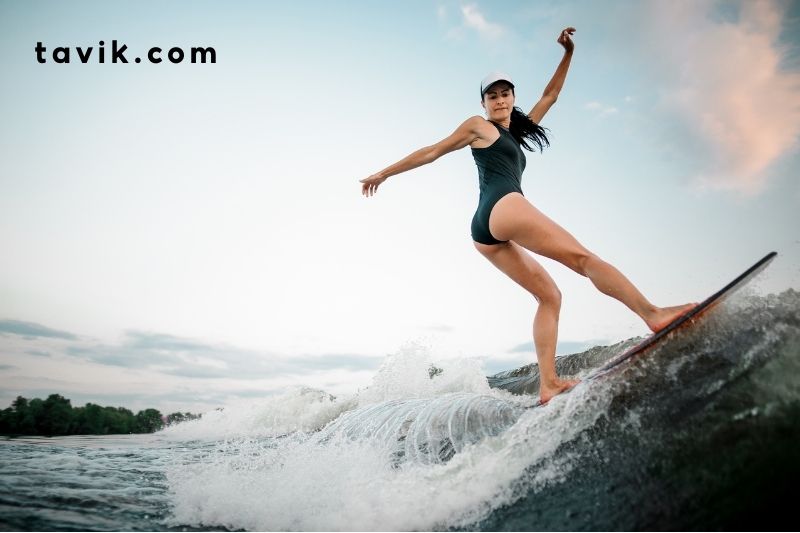 To acquire adequate speed, drift back into your sweet zone and give two to three solid pumps. Come down on your front foot weight and do a big bottom turn on your final pump. Come up to the top of the wake and turn around. As you climb, keep your front foot light and ride up until the whole board is off the wake. You may begin to put more weight on your front foot as you go down the wake. Your rear foot will rise up and even out over the lip due to this. You'll want to ensure that both your rear and front feet land even initially. Distribute your weight equally between your rear and front feet. https://www.youtube.com/watch?v=1Nyq0M5hwnw&ab_channel=ShaunMurray
To acquire adequate speed, drift back into your sweet zone and give two to three solid pumps. Come down on your front foot weight and do a big bottom turn on your final pump. Come up to the top of the wake and turn around. As you climb, keep your front foot light and ride up until the whole board is off the wake. You may begin to put more weight on your front foot as you go down the wake. Your rear foot will rise up and even out over the lip due to this. You'll want to ensure that both your rear and front feet land even initially. Distribute your weight equally between your rear and front feet. https://www.youtube.com/watch?v=1Nyq0M5hwnw&ab_channel=ShaunMurray
FAQs About How To Wake Surf
How do you execute a 360-degree turn?
Return to your sweet spot, somewhere between the center and outside of the wake. Get one or two suitable pumps in, or as many as possible, to produce speed. Lift your front foot off the wake surf board and lift your nose off the board. Next, you sink your backhand into the wake while simultaneously pushing your back foot out. This will loosen it up, allowing you to turn your body from left to right. As you grow more comfortable in your 360s, you'll notice that you're shifting your weight from front to back.
Conclusion
After testing out various ways to wake surf, we've come to the conclusion that the best ways to wake surf are by using a wake surfboard with or without fins. No matter what your skill level, wake surfing is a great way to enjoy the water and get a workout. So get out there and give it a try! Thank you for reading!
